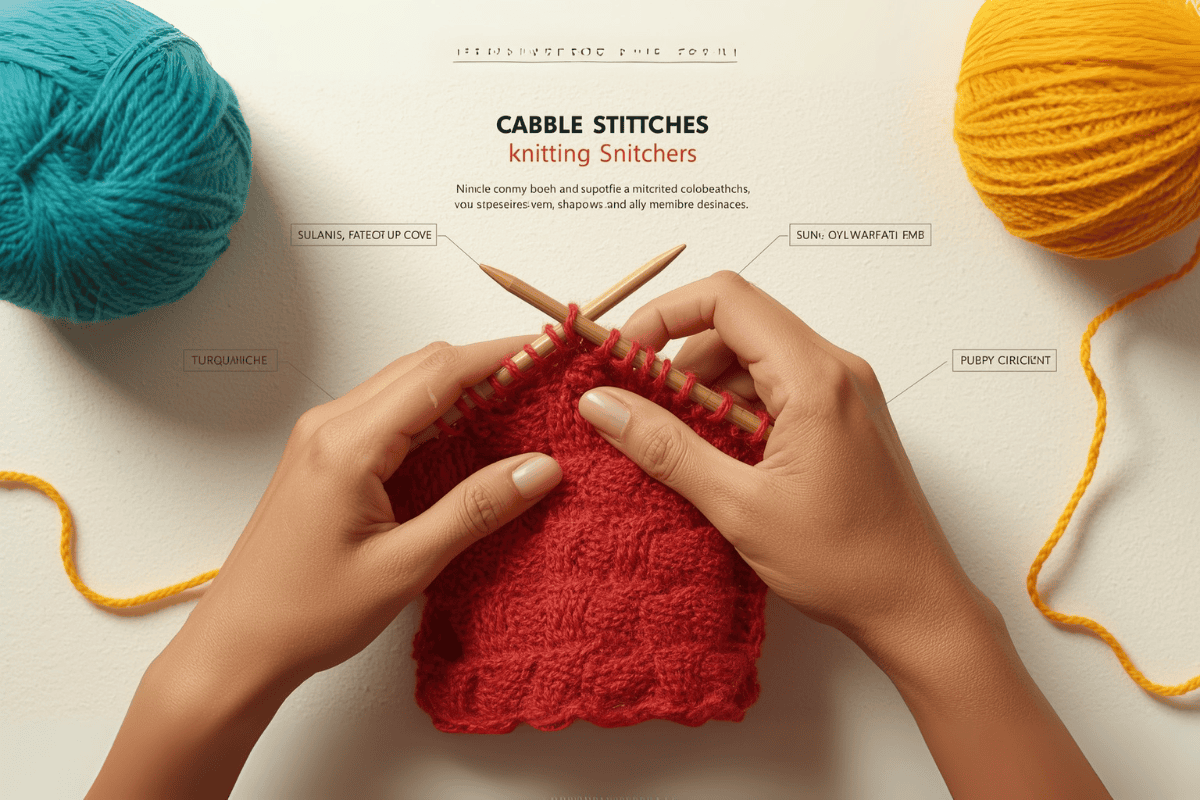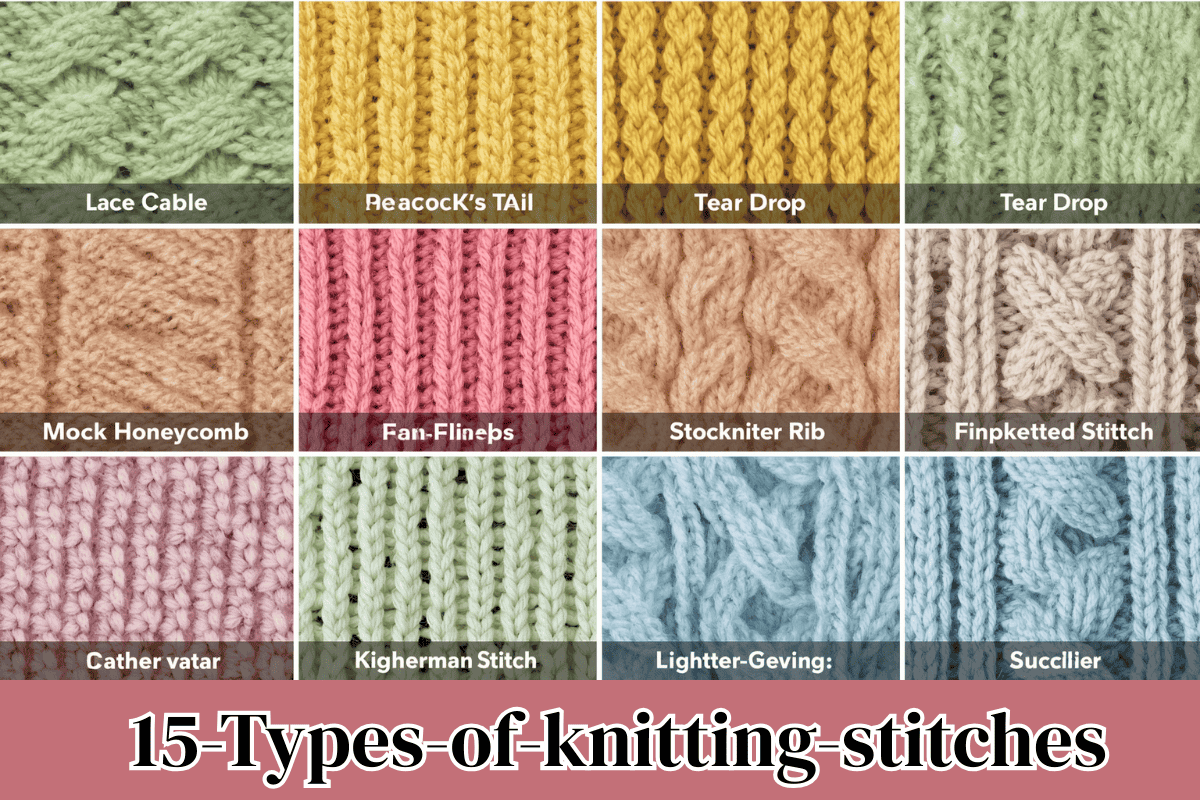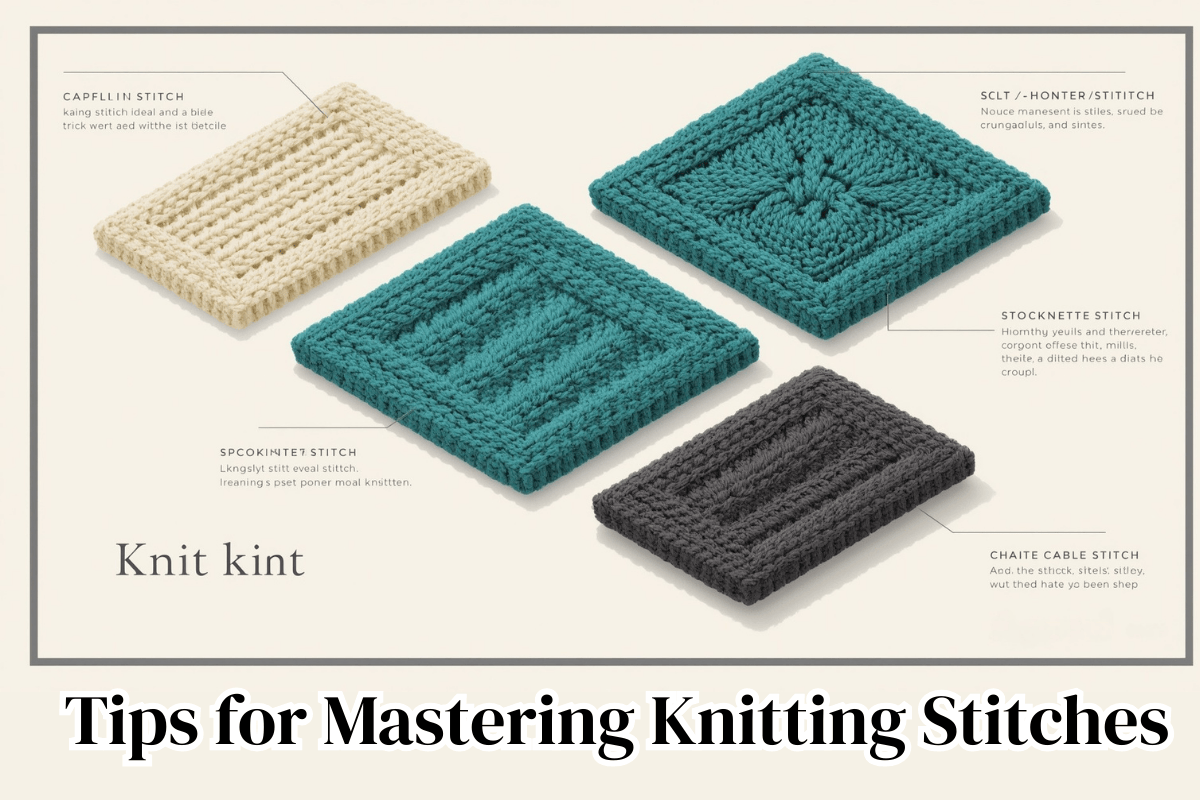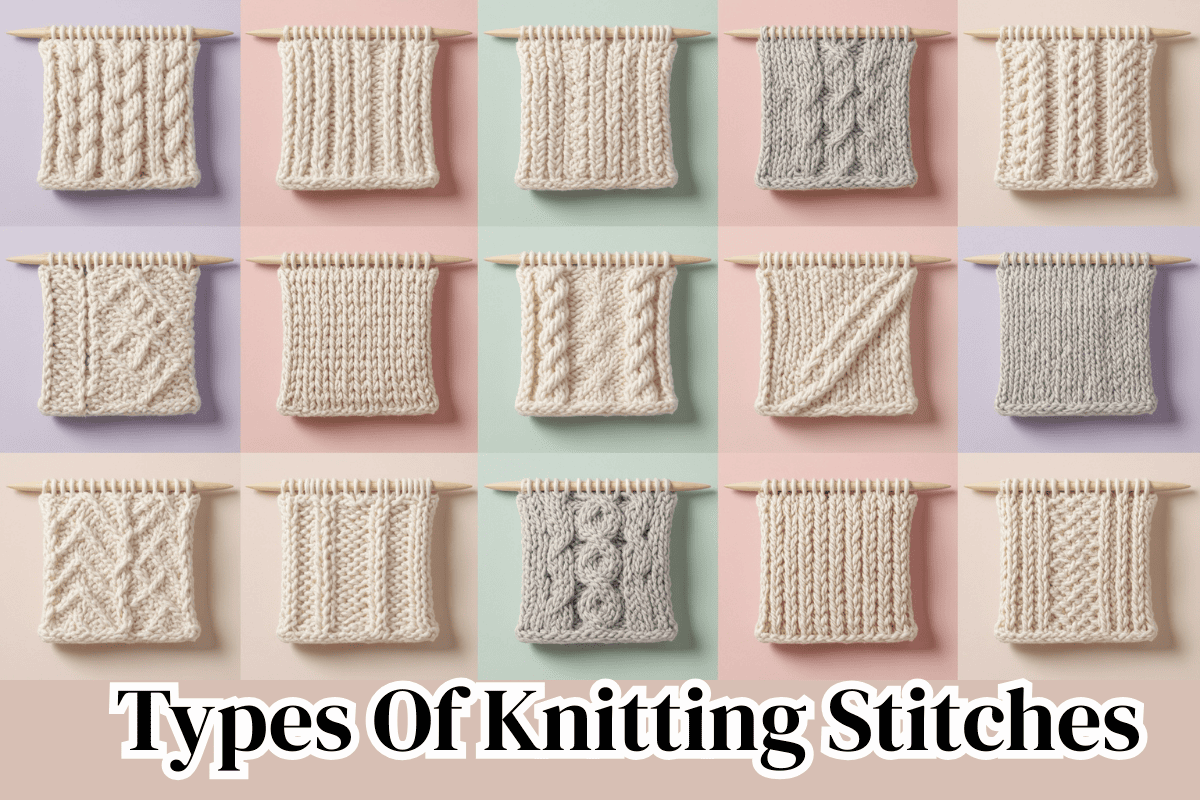Understanding the different types of knitting stitches starts with knowing that knitting differs from weaving completely. While weaving crosses threads over and under each other, knitting makes fabric by connecting yarn loops together using special needles. This method creates stretchy, soft materials.
Knitting has 2 main styles: weft knitting (done by hand or machine) and warp knitting (used in factories). These methods produce 4 basic fabric types: jersey, rib, interlock, and purl. Each type feels different and stretches in its own way.
Even though hundreds of stitch patterns exist today, they all start from just 2 simple stitches: the knit stitch and the purl stitch. These basic moves combine in endless ways. You can make simple patterns like stockinette stitch or create fancy designs with cables, lace holes, and colorful pictures.
Understanding the Basics of Knitting Stitches

What is knitting? Knitting is a fun craft. You create fabric by linking loops of yarn. You use special needles to make these loops. A knitting stitch is one small loop. Many stitches together make beautiful patterns.
Different types of knitting stitches create amazing effects. Some stitches make smooth fabric for t-shirts. Other stitches add cool textures to scarves. Your finished project looks different based on your stitch choice.
Every knitter needs two basic stitches. The knit stitch and purl stitch are most important. These foundation stitches mix in different ways. They create all other stitch patterns you see.
What is knit versus what is a purl stitch? The knit stitch makes smooth “V” shapes. The purl stitch creates bumpy horizontal lines. You combine these moves to make endless patterns.
Your knitting needles and yarn matter too. Thick yarn creates big stitches. Thin yarn makes small, delicate stitches. You choose materials based on your project needs.
Top 15 Types of Knitting Stitches

Here are popular types of knitting stitches for young knitters:
Stockinette Stitch
What is stockinette stitch? This classic stitch makes smooth fabric. One side looks smooth. The other side feels bumpy. You make it by switching knit and purl rows.
Stockinette stitch knitting works great for sweaters. It also fits well for tank tops. The fabric stretches nicely around your body. Stockinette fabric curls at edges though. You need borders to keep it flat.
This stitch uses less yarn than textured patterns. It saves money on big projects like blankets.
Garter Stitch
What is garter stitch in knitting? This easy pattern uses only knit stitches. You knit every single row. What is a garter stitch result? It makes squishy, stretchy fabric.
Garter stitch knitting never curls at edges. This makes it perfect for beginners. The texture looks the same on both sides. You never worry about right or wrong sides.
Scarves look amazing in garter stitch. Baby blankets also work well. Dishcloths use this stitch often.
Ribbing
Ribbing makes stretchy bands for clothes. You switch between knit and purl stitches. Common types include 1×1 and 2×2 ribbing. The numbers tell you how many stitches to make.
Sweater bottoms use ribbing often. Sleeve cuffs also need this stretch. Sock tops require ribbing too. The vertical lines help clothes fit better.
Seed Stitch
Seed stitch switches single knit and purl stitches. You change the pattern between rows too. This creates bumpy texture like scattered seeds. The fabric lies flat without curling.
Scarves look great in seed stitch. Borders use this pattern often. The texture shows up well in solid colors.
Basketweave Stitch
Basketweave stitch looks like woven baskets. You make squares of knit and purl stitches. Most patterns use 4 to 6 stitches per square. The squares switch positions between rows.
Blankets showcase basketweave beautifully. Pillow covers also work well. The pattern needs solid colors to show clearly.
Cable Stitch
Cable stitches make twisted rope patterns. You cross groups of stitches over each other. You need a special cable needle for this. Cables range from simple to very complex.
Traditional fisherman sweaters use elaborate cables. Light colored yarns show cables best. Smooth yarns work better than fuzzy ones.
Chevron Stitch
Chevron stitch creates zigzag patterns. You increase and decrease stitches strategically. The pointed “V” shapes stack up nicely. This makes dynamic visual movement.
Chevron works great with striped yarns. Blankets use this pattern often. The points look good with fringe added.
Lace Stitch
Lace stitch patterns make decorative holes. You use special techniques called yarn-overs. You also decrease stitches in certain spots. The holes create beautiful patterns.
Summer tops showcase lace perfectly. Shawls also use lace often. Light colored smooth yarns work best. The patterns show up clearly this way.
Brioche Stitch
Brioche creates thick, squishy fabric. The technique uses yarn-overs and slipped stitches. The result looks ribbed but feels softer. This stitch makes very warm clothes.
Cozy scarves use brioche often. Hats also benefit from this warmth. The technique uses more yarn though. The extra warmth makes it worthwhile.
Entrelac Stitch
Entrelac looks like woven fabric. You work small squares that interlock together. You pick up stitches from finished sections. This creates amazing geometric patterns.
Blankets show entrelac beautifully. Decorative bags also work well. Multiple colors create maximum visual impact.
Slip Stitch
Slip stitch patterns move stitches without working them. You pass stitches between needles. This simple technique creates amazing color patterns. You can make stripes and checks easily.
Beginners can try colorful patterns this way. The technique is easier than complex color work. Two colors create the most dramatic effects.
Double Knit Stitch
Double knitting makes reversible fabric. Both sides look like the right side. You work with two colors at once. The patterns appear opposite on each side.
Scarves benefit from double thickness. Hats also stay warmer this way. The double layer provides excellent insulation.
Moss Stitch
Moss stitch switches knit and purl stitches carefully. You work two rows before changing the pattern. This creates gentle horizontal texture lines. The fabric lies flat naturally.
Garment panels use moss stitch often. Borders also benefit from this structure. The pattern adds interest without bulk.
Irish Moss Stitch
Irish moss stitch combines moss and seed patterns. You use 2×2 blocks of stitches. The texture looks more geometric than regular moss. This pattern has slightly more stretch.
Sweater sections use Irish moss well. The pattern needs some stretch for comfort.
Waffle Stitch
Waffle stitch creates puffy, textured surfaces. The pattern looks like breakfast waffles. You push and pull fabric into raised squares. This provides excellent insulation.
Kitchen items benefit from waffle texture. Pot holders use this pattern often. Throw pillows also look great this way.
| Stitch Type | Difficulty Level | Best Project Uses | Yarn Amount Needed |
| Stockinette | Beginner | Sweaters, fitted clothes | Low |
| Garter | Beginner | Scarves, blankets | Medium |
| Ribbing | Beginner | Cuffs, hems | Low |
| Seed | Easy | Borders, textures | Medium |
| Cable | Advanced | Sweaters, accessories | Medium |
| Lace | Intermediate | Shawls, summer tops | Low |
| Brioche | Advanced | Warm accessories | High |
How to Choose the Right Knitting Stitch for Your Project
You need to pick the right stitch carefully. Different types of knitting stitches work for different projects. T-shirts need smooth stitches like stockinette stitch. The fabric drapes nicely and stretches well.
Scarves work great with garter stitch. The fabric does not curl at edges. It also feels cozy around your neck. Blankets can use many different stitch types.
You should think about texture too. Smooth fabrics use stockinette or ribbing patterns. Textured projects need seed stitch or cables. Your yarn choice affects which stitches work best.
Circular knitting needles vs straight knitting needles can change results. Some stitches work better with specific needle types. Beginners should start with simple patterns first.
Consider your skill level honestly. Garter stitch and stockinette work well for new knitters. Complex cables need more experience. Lace patterns require careful attention too.
A winter scarf works perfectly with garter stitch knitting. A summer tank top needs stockinette stitch in knitting. The right stitch makes your project successful.
Tips for Mastering Knitting Stitches

You can improve your types of knitting stitches with practice. Make small test squares before big projects. This lets you see how patterns look. You also waste less yarn on mistakes.
Purl stitch knitting needs consistent tension. You control how tightly you hold yarn. Too loose creates sloppy looking stitches. Too tight makes knitting very difficult.
Purling knitting gets easier with regular practice. Your hands learn the movements naturally. Muscle memory develops over time with repetition.
You should use stitch markers for complex patterns. These small rings mark important pattern spots. They prevent mistakes that ruin hours of work. Markers slip easily onto your needles.
Pattern reading becomes easier with experience. You learn stitch patterns knitting symbols gradually. Start with simple patterns first. Build your library of knitting stitches slowly.
Consistency creates professional looking results. You keep tension even throughout your work. Take breaks when you feel frustrated or tired. Even experts started with wobbly first stitches.
Frequently Asked Questions
What are the easiest types of knitting stitches for beginners?
Garter stitch and stockinette stitch are perfect for beginners. Garter stitch uses only knit stitches. Stockinette alternates knit and purl rows. Both create beautiful fabric with simple techniques.
How many types of knitting stitches exist?
Hundreds of types of knitting stitches exist worldwide. This guide covers 15 popular ones. Most patterns combine these basic stitches. You can create thousands of variations this way.
What is the difference between knit and purl stitches?
The knit stitch creates smooth “V” shapes. The purl stitch makes bumpy horizontal lines. You combine these two basic moves. They form the foundation for all other patterns.
Which knitting stitch uses the least yarn?
Stockinette stitch typically uses the least yarn. The fabric lies flat without extra texture. Dense textured stitches like brioche use more yarn. Lace patterns also use less yarn overall.
Can I mix different knitting stitches in one project?
Yes, you can combine different types of stitches in knitting. Many sweaters use ribbing for cuffs. The body might use stockinette. Cables often accent plain backgrounds beautifully.
What yarn works best for learning new stitches?
Smooth, light colored yarn shows stitches clearly. Medium weight yarn works well for practice. Avoid fuzzy or dark yarns when learning. You can see your stitches better this way.
How do I fix mistakes in different knitting stitches?
Small mistakes can often be fixed easily. You can drop down to the mistake. Then you rebuild stitches row by row. Complex patterns might need more careful correction.
Are some knitting stitches stronger than others?
Yes, some stitches create stronger fabric. Garter stitch makes very sturdy fabric. Ribbing also creates strong, stretchy material. Lace patterns are more delicate by design.
Conclusion
Different types of knitting stitches create endless creative possibilities. Young crafters can make trendy accessories easily. Cozy home decor also benefits from various techniques. Each stitch library knitting technique adds new project options.
You should start with simple stitches first. Garter and stockinette build good foundations. Complex patterns come easier with practice. Every expert knitter started as a complete beginner.
Bangladesh has become a major textile production hub. Many trusted clothing suppliers create beautiful knitted items there. The country’s garment industry produces everything from basic t-shirts to complex knitted garments.
Stocking stitch and other traditional techniques remain important. Modern manufacturers still use these time-tested methods. The best t-shirt manufacturers combine traditional skills with modern equipment.
Types of knit stitches offer something for everyone. You can create simple scarves or complex sweaters. The choice depends on your skill and ambition. Share your favorite patterns with other young knitters. The knitting community loves to help beginners succeed.
What stitches knitting projects will you try first? Start small and build your confidence gradually. Remember that mistakes are part of learning. Each project teaches you something new and valuable.

